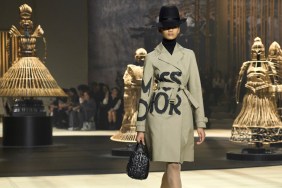Inge Jacobsen is an Irish-born, Sussex-based contemporary artist who recreates glossy magazine covers and customizes fashion ads by using cross-stitching and embroidery — she describes her work as an “intervention.” The photorealistic effect she’s able to achieve with full cross-stitched reproductions (see her version of British Vogue‘s March 2011 Rosie Huntington-Whiteley cover above, side-by-side with the original) is arresting, but I’m drawn to her more unpolished work, which uses sparse, minimal embroidery superimposed on fashion campaigns.
Here, for example, is an aggressively moody male face expressively stitched in multi-colored thread on top of Louis Vuitton‘s stark, fastidious Spring 2013 campaign:

I asked Jacobsen a bit about her practice, what drew her to fashion imagery and what it’s like making a living as a young artist.
theFashionSpot: Tell me about cross-stitching. Where did you learn how to do it and why have you stuck with the technique?
Inge Jacobsen: I learned it when I was a child and living in Denmark. My grandmother initially taught me but we also had to do it at school. I have stuck with it because I feel thread still has a lot more to offer me and it has also become my signature style.
tFS: Have you always wanted to be a visual artist?
IJ: Yes – ever since I was a child. I have always loved drawing and painting and art was always my favorite subject at school. I never felt that I was really good at anything else.

tFS: How would you characterize your relationship to fashion?
IJ: I wouldn’t say that my work was purely a celebration of fashion and the fashion industry. I think there are real issues in our society regarding the sexual objectification of women and girls and the pressure it puts on them to be a certain size and look a certain way. Sometimes it’s just a bit ridiculous.
The initial idea behind my practice was the photograph as an object – how it could be something to look at, rather than through or into. I started linking the idea of the photographic object and women as photographed objects, how they are treated as things to be gazed at and often appreciated for their physical beauty alone.

tFS: Could you talk a little about being a young artist and finances? Does art pay your bills?
IJ: I have to work to support my practice because with art, you never know where your next pay check is coming from and in real life it is important to have some stability. I plan on making art for the rest of my life, which means that now, at the start of my career, I don’t expect to have established myself enough to live a comfortable life from my art alone. I think young artists have to pay their dues, understand their practice and establish themselves in the industry before they can comfortably live off their work. I’ve been lucky so far but I have also worked very hard. This is a difficult and competitive industry and I don’t think it’s something anyone should go into for the money.








